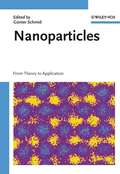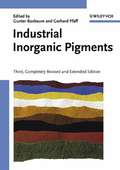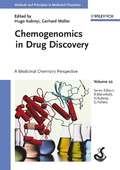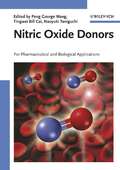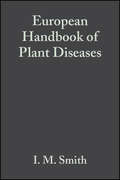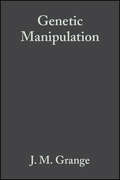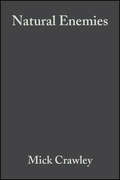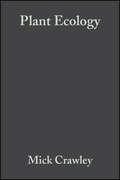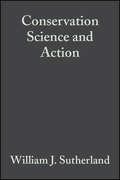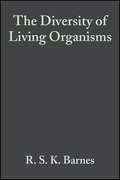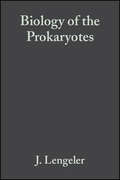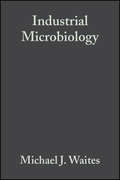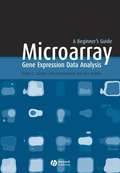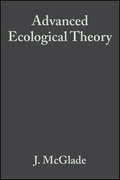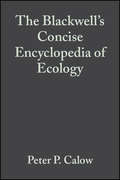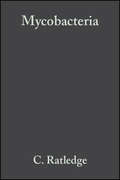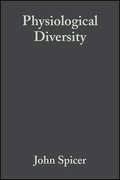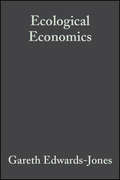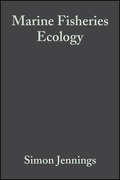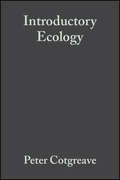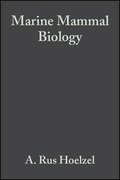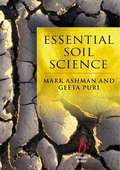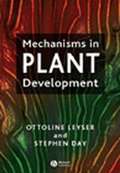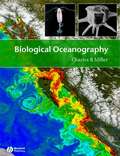- Table View
- List View
Nanoparticles: From Theory to Application
by Günter SchmidAn introduction to the science of nanoparticles, from fundamental principles to their use in novel applications. As a basis for understanding nanoparticle behavior, the book first outlines the principles of quantum size behavior, nanoparticles architecture, formation of semiconductor and metal nanoparticles. It then goes on to describe the chemical syntheses of nanoparticles with defined characteristics, their structural, electrical and magnetic properties, as well as current methods to monitor these properties. Among others, the following nanoparticle-based applications are discussed: Single-electron devices Ultra dense recording media Bioelectronic devices and sensors Labeling of proteins, nucleic acids and other biomaterials. With its clear structure and comprehensive coverage, backed by numerous examples from the recent literature, this is a prime reference for chemists and materials scientists working with and developing nanoparticle systems.
Industrial Inorganic Pigments
by Gunter Buxbaum Gerhard PfaffInorganic Pigments significantly change our surroundings. They are irreplaceable for the coloring of construction materials - their applications range from concrete to artist's colors, from industrial paints to toners in photocopiers, from coloring in foodstuffs to raw materials for catalysts. This book offers everything there is to know about inorganic pigments in a concise and thorough presentation: their manufacturing processes, their applications and markets, their testing procedures and standards, and also the health and environmental regulations relating to them. The reader is provided with more than 800 up-to-date references to the pertinent literature, which will be extremely useful for further studies. Over 30 first-class authors from leading chemical companies have created a uniform and clearly structured text, giving an excellent overview of the subject area. This book will be of benefit to all chemists, materials specialists, engineers, application technicians and students in pigment-related fields. '... the book under review is a class by itself...gives very useful information to the paint chemist regarding the basics and application aspects of the various pigments used in the chemical industry.' (Bulletin of Electrochemistry)
Chemogenomics in Drug Discovery: A Medicinal Chemistry Perspective (Methods and Principles in Medicinal Chemistry #22)
by Raimund Mannhold Gerd FolkersChemogenomics brings together the most powerful concepts in modern chemistry and biology, linking combinatorial chemistry with genomics and proteomics. This first reference devoted to the topic covers all stages of the early drug discovery process, from target selection to compound library and lead design. With the combined expertise of 20 research groups from academia and leading pharmaceutical companies, this is a must-have for every drug developer and medicinal chemist applying the powerful methods of chemogenomics to speed up the drug discovery process.
Nitric Oxide Donors: For Pharmaceutical and Biological Applications
by Peng George Wang Tingwei Bill Cai Naoyuki TaniguchiNitric oxide is a highly potent regulatory molecule with great pharmaceutical potential. This handbook fills a real gap in combining the chemistry of nitric oxide releasing substances with their practical applications in biology and drug design. It covers all classes of nitric oxide donors, from organic nitrates to nitroso compounds, guanidines and metal-NO complexes. In addition to a detailed treatment of the chemistry of NO donors, numerous examples of successful diagnostic and pharmacological applications are discussed, as well as further therapeutic targets for these substances.
Teflon, Post-it und Viagra: Große Entdeckungen durch kleine Zufälle (Erlebnis Wissenschaft)
by Martin SchneiderWas haben Penicillin und Röntgenstrahlen mit Teflonpfanne und Viagra gemeinsam? Ebenso wie Polyethylen oder die praktischen gelben Post-it-notes wurden sie zufällig entdeckt; die Erfolge ergaben sich "nebenbei", bei der Grundlagenforschung oder auf der Suche nach etwas völlig anderem. So mancher Flop im Labor führte so zu Produkten, die aus unserem heutigen Leben nicht mehr wegzudenken sind. Der allgegenwärtige Tesafilm etwa ist letztlich ein verunglücktes Wundpflaster, auf dem man heute sogar Daten wie auf CD-ROMs speichern kann. Und die Teflonpfanne verdanken wir nicht der Raumfahrt, sondern der Suche nach einem neuen Kältemittel für Kühlschränke Diese Geschichten rund um Zufälle in der Forschung, vom bekannten Wissenschaftsjournalisten Martin Schneider lebendig und nuancenreich erzählt, garantieren jede Menge Lesespaß. Die Reise durch drei Jahrhunderte Entdeckungsgeschichte zeigt, dass auch in der Wissenschaft nicht immer alles nach Plan läuft; selbst die besten Forscher brauchten oft ein Quäntchen Glück, um einen Treffer zu landen.
European Handbook of Plant Diseases (BS - Plant Pathology Publications)
by I. M. Smith J. Dunez D. H. Phillips R. A. Lelliott S. A. ArcherAn encyclopaedic treatment of plant diseases in Europe, this book is designed as a standard reference volume for the general working plant pathologist and those taking advanced training in plant pathology. It provides a clear, informed and authoritative summary of each entry by an appropriate specialist, with a selection of key references for further reading. The handbook covers the economic diseases of crops and forest trees in Europe, treated by pathogen and classed as pathogens of major, moderate and minor importance. Approximately 1000 organisms are covered in total, including 600 fungi, 100 bacteria, and 300 viruses and similar organisms
Genetic Manipulation: Techniques and Applications (Society for Applied Bacteriology)
by J. M. Grange K. R. Fox N. L. MorganGenetic manipulation is no longer the province of the specialized researcher. It is finding widespread application in all fields of medicine and biology. Nevertheless, application of these relatively new techniques to new areas of research is often fraught with unexpected problems and difficulties. Based on the Society for Applied Bacteriology's Autumn 1989 Conference, this unique volume covers a wide and very up-to-date range of techniques used in genetic engineering. These include the isolation and analysis of DNA and RNA from cells and tissues, the selection and use of phage and plasmic vectors for cloning DNA, the cloning procedures, the production and screening of genomic libraries, the production and use of DNA probes, the polymerase chain reaction and the synthesis of 'designer' genes. This volume contains many examples of the applications of the above and other techniques for genetic manipulation, to subjects as diverse as plant pathology, forensic science, bacterial taxonomy, cardiac research, diagnostic microbiology, food hygiene and sewage treatment.
Natural Enemies: The Population Biology of Predators, Parasites and Diseases
by Michael J. CrawleyThis book is about disease and death. It is an ecologist's view of Darwin's vivid evocation of Nature, red in tooth and claw. An international team of authors examines broad patterns in the population biology of natural enemies, and addresses general questions about the role of natural enemies in the population dynamics and evolution of their prey. For instance, how do large natural enemies like wolves differ from small natural enemies like bacterial diseases in their effects on prey abundance? Is it better to chase after prey, or sit and wait for it to come to you? How should prey behave in order to minimize the risk of being eaten? The answers are all in this fascinating senior undergraduate/postgraduate text.
Plant Ecology
by Michael J. CrawleyPlant ecology is the scientific study of the factors influencing the distribution and abundance of plants. This benchmark text, extremely well received in its first edition, shows how pattern and structure at different levels of plant organization--from ecophysiology through population dynamics to community structure and ecosystem function--are influenced by abiotic factors (eg, climate and soils) and by biotic factors (eg, competition and herbivory). Adopting a dynamic approach, this book combines descriptive text with theoretical models and experimental data. It will be invaluable reading for both student and practising ecologist alike. In this second edition, the structure of the book has been completely revised, moving from the small scale to the large scale, in keeping with contemporary teaching methods. This fresh approach allows consideration of several new and important topics such as plant secondary chemistry, herbivory, sex, and breeding systems. Additional chapters address topical applied issues in plant ecology including global warming, pollution and biodiversity. The latest edition of a very widely adopted textbook Written by a team of leading experts and edited by an international authority in the field
Conservation Science and Action
by William J. SutherlandConservation Science and Action is intended for upper-level undergraduate and graduate courses in conservation biology. This book reviews the latest thinking and approaches, and in doing so provides a readily accessible reference work for conservation professionals and managers. Because conservation biology is now one of the most dynamic disciplines in the life sciences, William Sutherland and his international team of authors have selected many of the liveliest topics where key advances are currently being made. They stress ideas, point to unresolved issues, and suggest possible future developments. Finally, since conservation is an applied subject, the book's emphasis throughout is on action. Essential reading for senior undergraduate and postgraduate students taking courses in conservation biology, one of the most dynamic disciplines in the life sciences. Contributions from leading figures in the field who have selected the liveliest topics where key advances are being made. Reviews the latest thinking and approaches. Contributors cover a range of taxonomic groups, include aquatic and terrestrial plants and animals, and give examples from around the world. Emphasis given to action, and all chapters have an applied component.
The Diversity of Living Organisms
by R. S. K. BarnesSuch is the pressure on teaching time in schools and universities that students are taught less and less of the diversity that is life on this planet. Most students, and indeed most professional biologists that these students become, know far more of cell function than of biodiversity. This text is a profusely illustrated, quick-reference guide to all types of living organisms, from the single-celled prokaryotes and eurkaryotes to the multicellular fungi, plants and animals. All surviving phyla and their component classes are characterised and described, as are their lifestyles, ecology, relationships, and within-group diversity (with orders displayed in list form). Overall, the book's aim is to provide biologists and others with a clear, concise picture of the nature of all groups of organisms with which they may be unfamiliar.
Biology of the Prokaryotes
by Hans G. Schlegel Joseph W. Lengeler Gerhart DrewsDesigned as an upper-level textbook and a reference for researchers, this important book concentrates on central concepts of the bacterial lifestyle. Taking a refreshingly new approach, it present an integrated view of the prokaryotic cell as an organism and as a member of an interacting population. Beginning with a description of cellular structures, the text proceeds through metabolic pathways and metabolic reactions to the genes and regulatory mechanisms. At a higher level of complexity, a discussion of cell differentiation processes is followed by a description of the diversity of prokaryotes and their role in the biosphere. A closing section deals with man and microbes (ie, applied microbiology). The first text to adopt an integrated view of the prokaryotic cell as an organism and as a member of a population. Vividly illustrates the diversity of the prokaryotic world - nearly all the metabolic diversity in living organisms is found in microbes. New developments in applied microbiology highlighted. Extensive linking between related topics allows easy navigation through the book. Essential definitions and conclusions highlighted. Supplementary information in boxes.
Industrial Microbiology: An Introduction
by Michael J. Waites Neil L. Morgan John S. Rockey Gary HigtonOf major economic, environmental and social importance, industrial microbiology involves the utilization of microorganisms in the production of a wide range of products, including enzymes, foods, beverages, chemical feedstocks, fuels and pharmaceuticals, and clean technologies employed for waste treatment and pollution control. Aimed at undergraduates studying the applied aspects of biology, particularly those on biotechnology and microbiology courses and students of food science and biochemical engineering, this text provides a wide-ranging introduction to the field of industrial microbiology. The content is divided into three sections: key aspects of microbial physiology, exploring the versatility of microorganisms, their diverse metabolic activities and products industrial microorganisms and the technology required for large-scale cultivation and isolation of fermentation products investigation of a wide range of established and novel industrial fermentation processes and products Written by experienced lecturers with industrial backgrounds, Industrial Microbiology provides the reader with groundwork in both the fundamental principles of microbial biology and the various traditional and novel applications of microorganisms to industrial processes, many of which have been made possible or enhanced by recent developments in genetic engineering technology. A wide-ranging introduction to the field of industrial microbiology Based on years of teaching experience by experienced lecturers with industrial backgrounds Explains the underlying microbiology as well as the industrial application. Content is divided into three sections: 1. key aspects of microbial physiology, exploring the versatility of microorganisms, their diverse metabolic activities and products 2. industrial microorganisms and the technology required for large-scale cultivation and isolation of fermentation products 3. investigation of a wide range of established and novel industrial fermentation processes and products
Microarray Gene Expression Data Analysis: A Beginner's Guide
by Helen Causton John Quackenbush Alvis BrazmaThis guide covers aspects of designing microarray experiments and analysing the data generated, including information on some of the tools that are available from non-commercial sources. Concepts and principles underpinning gene expression analysis are emphasised and wherever possible, the mathematics has been simplified. The guide is intended for use by graduates and researchers in bioinformatics and the life sciences and is also suitable for statisticians who are interested in the approaches currently used to study gene expression. Microarrays are an automated way of carrying out thousands of experiments at once, and allows scientists to obtain huge amounts of information very quickly Short, concise text on this difficult topic area Clear illustrations throughout Written by well-known teachers in the subject Provides insight into how to analyse the data produced from microarrays
Advanced Ecological Theory: Principles and Applications
by J. McGladeAdvanced Ecological Theory is intended for both postgraduate students and professional researchers in ecology. It provides an overview of current advances in the field as well as closely related areas in evolution, ecological economics, and natural-resource management, familiarizing the reader with the mathematical, computational and statistical approaches used in these different areas. The book has an exciting set of diverse contributions written by leading authorities.
Blackwell's Concise Encyclopedia of Ecology
by Peter P. CalowThe language of ecology has grown rapidly and changed extensively over the last decade. From Arrhenotoky to Psammosere; from the One-tailed test to Zoocoenosis, the Blackwell Concise Encyclopedia of Ecology provides concise, non-technical definitions of over 2000 ecological terms, covering the complete spectrum of pure and applied ecological research. The definitions are drawn from the Encyclopedia of Ecology and Environmental Management, and are fully cross-referenced. This is the most comprehensive and up-to-date dictionary of ecological terms available. It should be invaluable to students and researchers alike. Over 2000 terms defined Avoids technical jargon Fully cross-referenced Includes common abbreviations
Mycobacteria: Molecular Biology and Virulence
by C. Ratledge J. W. DaleTuberculosis continues to kills more people than any other single infective agent. The resurgence of the disease in many countries has produced a heightened awareness of the threat posed by mycobacterial infections. At the same time, there has been an explosion of knowledge of the fundamental properties of mycobacteria, most notably the determination of the complete genome sequence of Mycobacterium tuberculosis. This book provides an up-to-date account of these developments in the molecular biology and immunology of mycobacteria, coupled with allied advances of a more applied nature, such as the use of molecular techniques for diagnosis and epidemiological investigations. With chapters contributed from an international team of experts, it will not only be an essential reference text for the expanding mycobacterial research community, but also will find a prominent place on the shelves of clinicians, infectious disease and public health specialists, diagnostic laboratories, postgraduate students and indeed anyone concerned with the management and investigation of outbreaks of tuberculosis. Comprehensively covers recent advances in the molecular biology of the mycobacteria. First book to be published on this subject since the publishing of the complete genome for the tubercle bacillus (M. tuberculosis). Coincides with a worldwide resurgence of tuberculosis.
Physiological Diversity: Ecological Implications
by John Spicer Kevin GastonEcologists have always believed, at least to a certain extent, that physiological mechanisms serve to underpin ecological patterns. However, their importance has traditionally been at best underestimated and at worst ignored, with physiological variation being dismissed as either an irrelevance or as random noise/error. Spicer and Gaston make a convincing argument that the precise physiology does matter! In contrast to previous works which have attempted to integrate ecology and physiology, Physiological Diversity adopts a completely different and more controversial approach in tackling the physiology first before moving on to consider the implications for ecology. This is timely given the recent and considerable interest in the mechanisms underlying ecological patterns. Indeed, many of these mechanisms are physiological. This textbook provides a contemporary summary of physiological diversity as it occurs at different hierarchical levels (individual, population, species etc.), and the implications of such diversity for ecology and, by implication, evolution. It reviews what is known of physiological diversity and in doing so exposes the reader to all the key works in the field. It also portrays many of these studies in a completely new light, thereby serving as an agenda for, and impetus to, the future study of physiological variation. Physiological Diversity will be of relevance to senior undergraduates, postgraduates and professional researchers in the fields of ecology, ecological physiology, ecotoxicology, environmental biology and conservation. The book spans both terrestrial and marine systems.
Ecological Economics: An Introduction
by Gareth Edwards-Jones Ben Davies Salman S. HussainEcological economics is an exciting interdisciplinary field of study that combines insights from the natural sciences, economics, philosophy and other fields to develop innovative approaches to environmental problems. It draws on a wide range of analytical perspectives, some radical others more conventional, to build a more complete understanding of human-ecosystem interactions. Current research in the field includes work on nature conservation, land use planning, pollution control, natural resource management, and environmental impact assessment/evaluation. Ecological Economics provides a comprehensive introduction to the core themes, presented in a clearly structured style, with chapters tailored specifically to readers without any economic or philosophical training. There is an emphasis throughout on the complementary roles of economics, ethics and ecology in environmental decision-making processes. The book reviews the evolution of important ideas in the field, explores the fundamental philosophies underlying different approaches to environmental problems, explains in detail the specific tools and techniques used in these approaches, and gives numerous examples of how they can be applied. Special importance is attached to understanding both the advantages and limitations of different analyses, in order to provide a balanced and coherent view of how these different approaches interrelate and how their roles vary in different contexts. Written by three authors specializing in ecology, economics and philosophy, this textbook provides an excellent introduction to the field of ecological economics for students in the natural sciences and other environmental disciplines. It will also be of interest to a wide range of professionals and researchers involved in environmental management and policy, and thers including economists seeking to broaden their knowledge of new methodologies and approaches. Further reading suggestions and extensive references are provided for those interested in pursuing particular themes beyond the introductory level. The first introductory ecological economics text written specifically for natural scientists. Assumes no prior knowledge of economics or philosophy. Emphasises the complementary roles of ecology, economics and ethics in environmental decision-making processes. An emphasis on clarity and accessibility throughout.
Marine Fisheries Ecology
by Simon Jennings Michel Kaiser John D. ReynoldsThis topical and exciting textbook describes fisheries exploitation, biology, conservation and management, and reflects many recent and important changes in fisheries science. These include growing concerns about the environmental impacts of fisheries, the role of ecological interactions in determining population dynamics, and the incorporation of uncertainty and precautionary principles into management advice. The book draws upon examples from tropical, temperate and polar environments, and provides readers with a broad understanding of the biological, economic and social aspects of fisheries ecology and the interplay between them. As well as covering 'classical' fisheries science, the book focuses on contemporary issues such as industrial fishing, poverty and conflict in fishing communities, marine reserves, the effects of fishing on coral reefs and by-catches of mammals, seabirds and reptiles. The book is primarily written for students of fisheries science and marine ecology, but should also appeal to practicing fisheries scientists and those interested in conservation and the impacts of humans on the marine environment. particularly useful are the modelling chapters which explain the difficult maths involved in a user-friendly manner describes fisheries exploitation, conservation and management in tropical, temperate and polar environments broad coverage of 'clasical' fisheries science emphasis on new approaches to fisheries science and the ecosystem effects of fishing examples based on the latest research and drawn from authors' international experience comprehensively referenced throughout extensively illustrated with photographs and line drawings
Introductory Ecology
by Peter Cotgreave Irwin ForsethIn this age of increasing human domination of the Earth's biological and physical resources, a basic understanding of ecology is more important than ever. Students need a textbook that introduces them to the basic principles of ecological science, one that is relevant to today's world, and one that does not overwhelm them with detail and jargon. Peter Cotgreave and Irwin Forseth have designed this book to meet the needs of these students, by providing a basic synthesis of how individual organisms interact with their physical environment, and with each other, to generate the complex ecosystems we see around us. The unifying theme of the book is biodiversity-its patterns, causes, and the growing worldwide threats to it. Basic ecological principles are illustrated using clearly described examples from the current ecological literature. This approach makes the book valuable to all students studying ecology. Examples have been chosen carefully to represent as wide a range of ecosystems (terrestrial and aquatic, northern and southern hemisphere) and life forms (animal, plant and microbe) as possible. Particular attention is paid to consequences of global change on organisms, populations, ecological communities and ecosystems. The end result is a text that presents a readable and persuasive picture of how the Earth's natural systems function, and how that functioning may change over the coming century. Features include: · strong coverage of applied and evolutionary ecology · applications of ecology to the real world · a question-orientated approach · the only comprehensive treatment of ecology written for the introductory student · an emphasis on definitions of key words and phrases · an integration of experimental, observational and theoretical material · examples drawn from all over the world and a wide variety of organisms · a logical structure, building from the response of individual organisms to physical factors, through population growth and population interactions, to community structure and ecosystem function · suggested further reading lists for each chapter · boxes to explain key concepts in more depth · dedicated textsite featuring additional information and teaching aids www.blackwellpublishing.com/cotgreave Peter Cotgreave is an animal ecologist who has worked for the University of Oxford and the Zoological Society of London. His research interests centre on abundance and rarity within animal communities. Irwin Forseth is a plant physiological ecologist who has taught introductory ecology and plant ecology at the University of Maryland since 1982. His research focuses on plant responses to the environment. The authors have studied organisms as diverse as green plants, insects and mammals in habitats from deserts to tropical rainforests. They have worked in ecological research and education in Africa, Asia, North and South America, Europe and the Caribbean.
Marine Mammal Biology: An Evolutionary Approach
by A. Rus HoelzelThis book provides a general introduction to the biology of marine mammals, and an overview of the adaptations that have permitted mammals to succeed in the marine environment. Each chapter, written by experts in their field, will provide an up-to-date review and present the major discoveries and innovations in the field. Important technical advances such as satellite telemetry and time-depth-recorders will be described in boxes.
Essential Soil Science: A Clear and Concise Introduction to Soil Science
by Mark Ashman Geeta PuriThis textbook is aimed at the majority of students, who need to quickly acquire a concise overview of soil science. Many current soil science textbooks still cater for a traditional student market where students embark on three years study in a narrow discipline. The growth in modular degree schemes has meant that soil science is now often taught as self-standing unit as part of broad based degree program. Students pursuing this type of course are increasingly reluctant to purchase expensive textbooks that are too detailed and often assume a scientific background. For those opting to specialise in soil science there are a variety of good textbooks to choose from. This short informative guide, will be particularly useful for students who do not possess a traditional scientific background, such as those studying geography, environment science, ecology and agriculture. Only textbook to cater for introductory courses in soil science. Provides an affordable concise overview of soil science. Learning exercises and chapter summaries enhance usability. Annotated suggestions for further reading. Based on proven and successful modular course structure. Emphasis on readability and interactive learning. No scientific background assumed.
Mechanisms in Plant Development
by Ottoline Leyser Stephen DayIntended for undergraduate and graduate courses in plant development, this book explains how the cells of a plant acquire and maintain their specific fates. Plant development is a continuous process occurring throughout the life cycle, with similar regulatory mechanisms acting at different stages and in different parts of the plant. Rather than focussing on the life cycle, the book is structured around these underlying mechanisms, using case studies to provide students with a framework to understand the many factors, both environmental and endogenous, that combine to regulate development and generate the enormous diversity of plant forms. New approach to the study of plant development and a refreshing look at this fast-moving area. Authors focus their discussion on the basic mechanisms which underpin plant development, tackling the fundamental question of how a single cell becomes a complex flowering plant from a cellular perspective. An up-to-date, modern text in plant development for advanced level undergraduates and postgraduates in plant science. Thought-provoking treatment of a difficult subject, the text will satisfy the needs of advanced level undergraduates and postgraduates in plant science. Experimental case studies throughout. The artwork from the book is available at www.blackwellpublishing.com/leyser
Biological Oceanography
by Charles B. MillerThis modern textbook of biological oceanography is aimed at students taking oceanography, marine biology and marine sciences courses. It covers recent developments such as the molecular techniques (including sequence data) that have allowed a re-examination of the ocean's microbial ecology and the role of the various trophic groups in biogeochemical cycling, carbon flow and climate control. Major topics covered include phytoplankton bloom, microbial food web, marine biogeography, global climate change and an overview of fisheries oceanography. Difficult concepts are explained in a straightforward manner, making this book accessible to undergraduates, graduates and researchers alike. Features a chapter on important numerical models which have become indispensable in biological oceanography. Further details of key terms and important topics are highlighted in boxes Models, formulas, methodologies, and techniques are described and explained throughout. An Instructor manual CD-ROM for this title is available. Please contact our Higher Education team at HigherEducation@wiley.com for more information.
